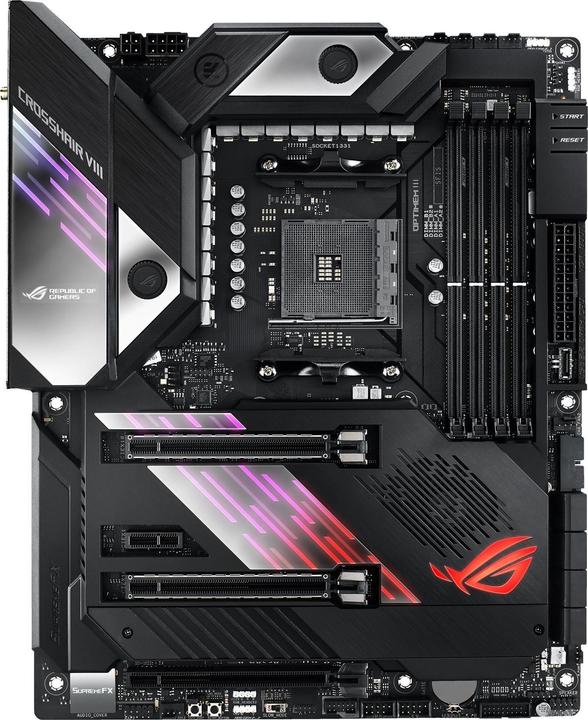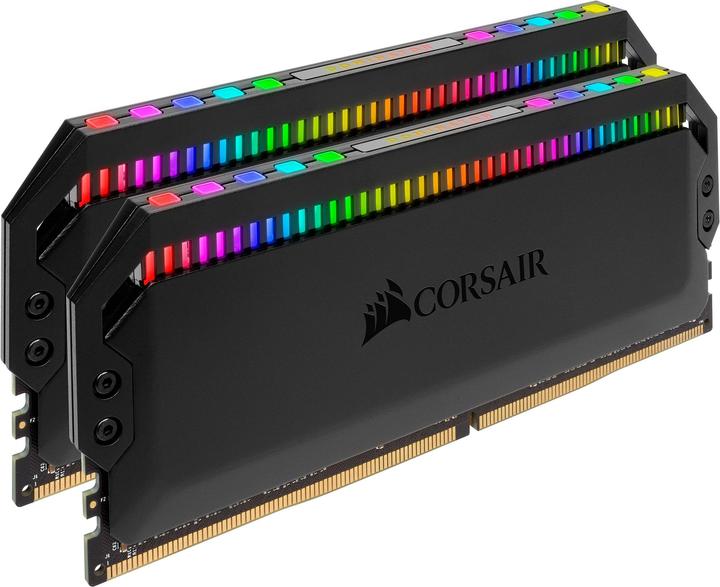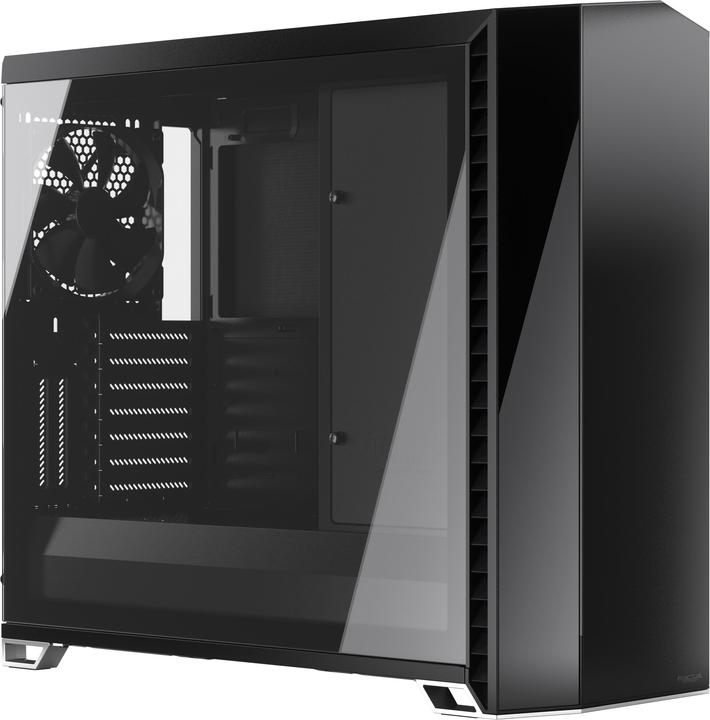
Housing with a slanted top: review of the Vector RS
The Swedish case manufacturer Fractal Design is known for simplicity. The Vector RS dances with its glass "sloping roof" at least a little out of line and surprises with its airflow.
The first thing that catches the eye on the Vector RS is the glass top. It looks cool and provides an unusual view of the components. However, I have concerns: does the housing have enough airflow? The only way to remove hot air is at the back of the case and only with one fan.

Note: You can read in the article that this is my first systematised case review. However, the review of the Define 7 has been online since 20/02/2020. I did the review of the Vector RS before the Define 7 - as a prototype for the systematised tests. Certain statements about cooling performance should therefore be treated with caution. Nevertheless, I don't want to withhold anything from you.
Scope of delivery and modularity
A look at the scope of delivery shows that I might be right with my concerns. Fractal includes an alternative top panel that is supposed to ensure better airflow. A bracket for radiators at the top and a dust filter are also included. Various screws, cable ties and an RGB controller are also included. You will need this if you want to operate the case's RGB bar and do not have a motherboard from ASrock, Asus, MSI or Gigabyte. Unfortunately, the RGB bar on my tested case is defective. The bar does not flash either via the corresponding connection on the mainboard or the RGB controller. The case is therefore currently not available from us, as the bar is being reworked.
The available form factors are ATX, mATX, Mini ITX and E-ATX. E-ATX mainboards can be a maximum of 285 millimetres wide. For drives, the Vector RS offers eight bays in the standard layout, two of which can be used exclusively for 2.5-inch drives and six of which can also be used for 3.5-inch drives. The two brackets for the 2.5-inch drives are located in the bottom right rear section. The drives are screwed onto brackets and these in turn are screwed vertically into the housing. The other brackets work in a similar way, but the drives are mounted horizontally in the bay. This is located at the rear left.
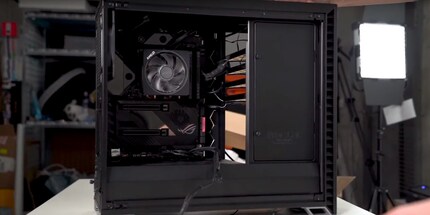
Alternatively, the left drive bay can be removed and the case can be operated in an open layout. To do this, the entire roof must be removed. The drive bay's privacy panel is then moved back. Two 3.5-inch drives can still be mounted vertically on the rear of the panel. While we're on the subject of alternative placement options: The two 2.5-inch drive brackets can also be mounted on the front of the power supply cover.
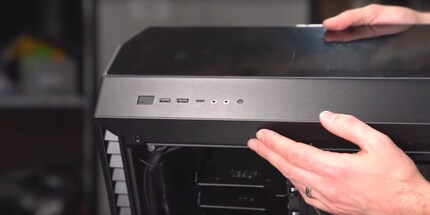
In the standard layout with the six drive bays, a maximum of eight 140-millimetre or nine 120-millimetre fans can be installed. In the open layout, there are nine 140-millimetre and nine 120-millimetre fans. For the radiators, there is a maximum of one 420-millimetre fan (in the open layout) or one 360-millimetre fan (in the standard layout) at the top. Radiators up to 360 millimetres are possible at the front and up to 280 millimetres at the bottom in both layouts.
The 552×233×498 millimetre case weighs around 12.5 kilograms net.
How does it build inside the housing?
I could basically post my experiences with the Meshify S2 here. The internal construction of the case is more or less identical. If you're interested in water cooling, you can read more about it in the following article.
Because I install the components of our testbench - i.e. everything air-cooled - in the case, the construction process is different to that of the Meshify S2. It's a lot easier and the components are in the case in just under half an hour. Fractal has thought of almost everything in terms of cable management on the front of the case. The housing feed-throughs are perfectly positioned and offer sufficient space for front connection, mainboard and graphics card cables. With the exception of the opening on the left of the power supply cover, each one is protected from view by a rubber seal.
On the rear of the case, I find Fractal's solution less skilful. The manufacturer includes a fan controller. Practical, but depending on the type and number of fans used, it may not be usable. If you remove it, you will find two spacers underneath. These are welded to the back of the housing. This takes away space for cables and the possibility of attaching other devices there.
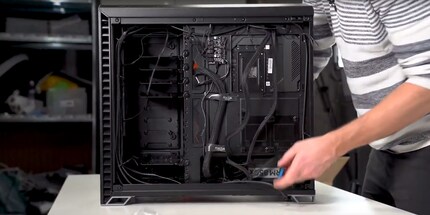
Other than that, I find the space for the cables, especially in the depth, a bit tight. I also miss effective cable guides. There are two Velcro straps, but only in the centre of the rear of the case - and this is exactly where the space in the depth is lacking. I have to use cable ties on the left and right and the cables somehow end up between the rear panel and the back of the case. The case should be one to two centimetres wider so that there is enough space for cable management.
Test methodology
The most important aspect of a case is the airflow. In other words, how efficiently is fresh, cool air transported into the case and out again? To test this, I stress the following components installed in the case using the HeavyLoad (for the CPU) and FurMark (for the GPU) stress tests:
I use the AMD Wraith Prism as the CPU cooler.
I run the stress tests for 20 minutes. I measure the temperature with three thermometers at different points: One thermometer measures the ambient temperature. For better comparability, I do the tests in our studio in the basement. The average temperature there is 20° Celsius. I place another thermometer in the centre of the case in front of the graphics card. I attach the last thermometer with adhesive tape behind the fan at the end of the case. I use three case fans: two at the front and one at the back. I set them to 100 per cent power in the BIOS.
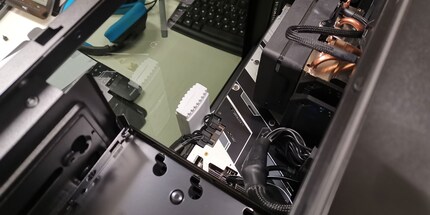
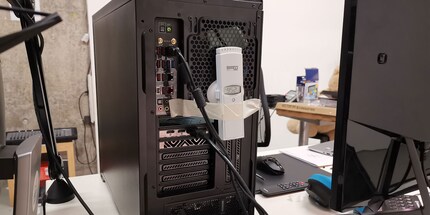
I run the tests four times. Two times each with the included Dynamic X2 GP-14 fans from Fractal Design and two times with Noctua NF-A14 PWM. I use the Noctua fans so that I can compare the airflow in future case reviews. I conduct the first test with a glass top panel and the second with a ventilation slot top panel and dust filter.
After five, ten and 20 minutes, I note the temperature of the thermometers, CPU and GPU. After each test, I switch off the system and let it cool down for a quarter of an hour.
How good is the airflow?
This is how the Vector RS performs in these tests:
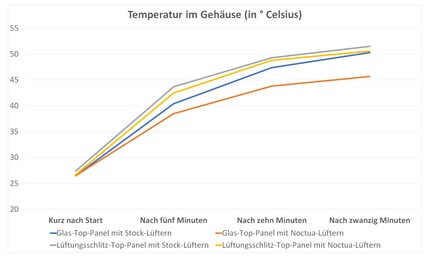
During the test, I realised that it makes no sense to take the temperature after a few seconds as the value is not accurate enough. In future, I will take the temperature after five minutes of idle time and only then start the tests. I will then take the temperature every five minutes so that I have even more values. Here are all the values in tabular form:
| Temperatures | Glass top panel with stock fans | Glass top panel with Noctua fans | Ventilation slot top panel with stock fans | Fan slot top panel with Noctua fans |
|---|---|---|---|---|
| Temperature environment
a few seconds after start / after five minutes / after ten minutes / after twenty minutes | 20.9° Celsius / 21.0° Celsius / 21.1° Celsius / 21.4° Celsius | 21.1° Celsius / 21.2° Celsius / 21.3° Celsius / 21.6° Celsius | 21.3° Celsius / 21.4° Celsius / 21.5° Celsius / 21.8 | 20.6° Celsius / 20.7° Celsius / 20.8° Celsius / 21.1° Celsius |
| Temperature in the housing
a few seconds after start / after five minutes / after ten minutes / after twenty minutes | 26.5° Celsius / 40.4° Celsius / 47.4° Celsius / 50.3° Celsius | 26.5° Celsius / 38.5° Celsius / 43.8° Celsius / 45.7° Celsius | 27.4° Celsius / 43.7° Celsius / 49.3° Celsius / 51.5° Celsius | 26.7° Celsius / 42.5° Celsius / 48.8° Celsius / 50.6° Celsius |
| Temperature behind housing
a few seconds after start / after five minutes / after ten minutes / after twenty minutes | 25.6° Celsius / 31.8° Celsius / 36.2° Celsius / 38.7° Celsius | 25.1° Celsius / 28.2° Celsius / 29.9° Celsius / 30.5° Celsius | 26.9° Celsius / 32.8° Celsius / 36.4° Celsius / 38.3° Celsius | 23.9° Celsius / 29.4° Celsius / 32° Celsius / 33.3° Celsius |
| Temperature CPU
a few seconds after start / after five minutes / after ten minutes / after twenty minutes | 79° Celsius / 87° Celsius / 90° Celsius / 91° Celsius | 71° Celsius / 84° Celsius / 85° Celsius / 85° Celsius | 79° Celsius / 87° Celsius / 89° Celsius / 91° Celsius | 69° Celsius / 82° Celsius / 83° Celsius / 84° Celsius |
| Temperature GPU
a few seconds after start / after five minutes / after ten minutes / after twenty minutes | 70° Celsius / 77° Celsius / 79° Celsius / 80° Celsius | 63° Celsius / 78° Celsius / 79° Celsius / 79° Celsius | 71° Celsius / 78° Celsius / 79° Celsius / 80° Celsius | 60° Celsius / 78° Celsius / 80° Celsius / 81° Celsius |
| RAM temperature
a few seconds after start / after five minutes / after ten minutes / after twenty minutes | 72° Celsius / 84° Celsius / 86° Celsius / 88° Celsius | 64° Celsius / 84° Celsius / 86° Celsius / 86° Celsius | 72° Celsius / 86° Celsius / 88° Celsius / 88° Celsius | 60° Celsius / 84° Celsius / 86° Celsius / 88° Celsius |
| Temperature VRAM
a few seconds after start / | 56° Celsius / 73° Celsius / 76° Celsius / 77° Celsius | 47° Celsius / 73° Celsius / 75° Celsius / 75° Celsius | 57° Celsius / 74° Celsius / 76° Celsius / 77° Celsius | 44° Celsius / 73° Celsius / 76° Celsius / 77° Celsius |
That's a lot of figures. For better comparability in future case reviews, I show the temperatures after twenty minutes in the case in the standard configuration and with optimised airflow. In this case, I am referring to the glass top panel (standard) and the ventilation slot top panel (optimised airflow). This allows a brief comparison of the tested cases. Now the whole thing still looks a bit bleak.
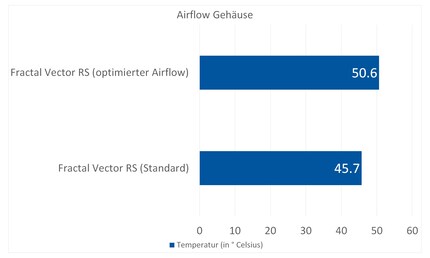
What do the results mean? My concerns about glass-top panels have not materialised. The values are even better with the glass top than with the ventilation slot top. This is probably due to the fact that the glass top generates more positive pressure and the hot air is therefore dissipated more efficiently than with the ventilation slot top. The temperature behind the housing also speaks in favour of this: it is lower with the glass top than with the ventilation slot top. In order for the ventilation slot top to fulfil its purpose, fans would have to be mounted on it.
The configuration has no major influence on the components. The maximum difference is 2° Celsius. The results for the VRAM and RAM temperatures are best with a glass top and Noctua fan. The difference is 2° Celsius. The same applies to the GPU: the temperature difference with the Noctua fans is two degrees, I measured no difference with the stock fans. For the CPU, the temperature difference between the two layouts with Noctua fans is only 1° Celsius. I measured no difference with the stock fans.
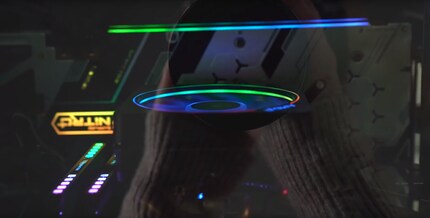
In addition to the temperature differences in the case, the CPU temperature is lower with the Noctua fans in both configurations than with the stock fans. Differences of 6° Celsius with the glass top and 7° Celsius with the ventilation slot top are enormous. This is probably due to the higher static pressure of the Noctua fans.
Surprisingly good airflow with glass top
The Vector RS offers all the features that a modern PC case needs to offer, including an RGB bar - if it works. Inside, the case has the same structure as the Define R6. Basically, all Fractal midi towers are more or less identical on the inside. That's why I always praise and criticise the same things - such as the lack of depth at the back, but praise for the modularity.
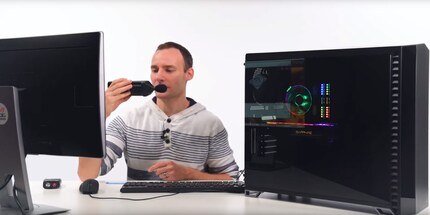
When it came to the airflow, I was proved wrong: hot air is dissipated more efficiently with a glass top panel than with a fan slot panel. At the moment, I can't tell you how good the airflow actually is compared to other cases due to a lack of comparative data.
This was my first systematised case review. Feel free to offer constructive criticism for future reviews in the comments column, that way everyone wins.
Speaking of winning: Fractal Design is providing us with two Vector RS to give away. All you have to do is click on "Take part" below. The random generator will decide who wins. You have until 12 March 2020 to take part.
Fractal Design Vector RS
Do you want to win one of two Vector RS cases? Then enter the contest!
The competition has ended.
From big data to big brother, Cyborgs to Sci-Fi. All aspects of technology and society fascinate me.


